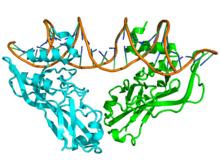T-box
T-box refers to a group of transcription factors involved in embryonic limb and heart development.[1] Every T-box protein has a relatively large DNA-binding domain, generally comprising about a third of the entire protein that is both necessary and sufficient for sequence-specific DNA binding. All members of the T-box gene family bind to the "T-box", a DNA consensus sequence of TCACACCT.[2]
| T-box | |||||||||||
|---|---|---|---|---|---|---|---|---|---|---|---|
 Crystallographic structure of the TBX3 protein dimer (cyan and green) complexed with DNA (brown) based on the PDB: 1h6f coordinates. | |||||||||||
| Identifiers | |||||||||||
| Symbol | T-box | ||||||||||
| Pfam | PF00907 | ||||||||||
| InterPro | IPR001699 | ||||||||||
| PROSITE | PS50252 | ||||||||||
| SCOPe | 1xbr / SUPFAM | ||||||||||
| |||||||||||
Mutations in the first one found caused short tails in mice, and thus the protein encoded was named brachyury, Greek for "short-tail". In mice this gene is named "T", but in humans it is named "TBXT".[3][4] Brachyury has been found in all bilaterian animals that have been screened, and is also present in the cnidaria.[5]
The mouse T gene was cloned,[6] and proved that brachyury was a 436 amino acid embryonic nuclear transcription factor. Brachyury binds to the T-box, through a region at its N-terminus.
Protein activity
The encoded proteins of Tbx5 and Tbx4 play a role in limb development, and play a major role in limb bud initiation specifically.[7] For instance, in chickens Tbx4 specifies hindlimb status while Tbx5 specifies forelimb status.[8] The activation of these proteins by Hox genes initiates signaling cascades that involve the Wnt signaling pathway and FGF signals in limb buds.[7] Ultimately, Tbx4 and Tbx5 lead to the development of apical ectodermal ridge (AER) and zone of polarizing activity (ZPA) signaling centers in the developing limb bud, which specify the orientation growth of the developing limb.[7] Together, Tbx5 and Tbx4 play a role in patterning the soft tissues (muscles and tendons) of the musculoskeletal system.[9]
Defects
In humans, and some other animals, defects in the TBX5 gene expression are responsible for Holt-Oram syndrome, which is characterized by at least one abnormal wrist bone. Other arm bones are almost always affected, though the severity can vary widely, from complete absence of a bone, to only a reduction in bone length.[10][11] Seventy-five percent of affected individuals also have heart defects, most often there is no separation between the left and right ventricle of the heart.[12]
TBX3 is associated with ulnar-mammary syndrome in humans, but is also responsible for the presence or absence of dun color in horses, and has no deleterious effects whether expressed or not.[13]
T-box genes
Genes encoding T-box proteins include:
See also
References
- Wilson V, Conlon FL (2002). "The T-box family". Genome Biology. 3 (6): REVIEWS3008. doi:10.1186/gb-2002-3-6-reviews3008. PMC 139375. PMID 12093383.
- Müller, CW; Herrmann, BG (23 October 1997). "Crystallographic structure of the T domain-DNA complex of the Brachyury transcription factor". Nature. 389 (6653): 884–8. doi:10.1038/39929. PMID 9349824.
- "Entrez Gene: T".
- Edwards YH, Putt W, Lekoape KM, Stott D, Fox M, Hopkinson DA, Sowden J (March 1996). "The human homolog T of the mouse T(Brachyury) gene; gene structure, cDNA sequence, and assignment to chromosome 6q27". Genome Research. 6 (3): 226–33. doi:10.1101/gr.6.3.226. PMID 8963900.
- Scholz CB, Technau U (January 2003). "The ancestral role of Brachyury: expression of NemBra1 in the basal cnidarian Nematostella vectensis (Anthozoa)". Development Genes and Evolution. 212 (12): 563–70. doi:10.1007/s00427-002-0272-x. PMID 12536320.
- Herrmann BG, Labeit S, Poustka A, King TR, Lehrach H (February 1990). "Cloning of the T gene required in mesoderm formation in the mouse". Nature. 343 (6259): 617–22. Bibcode:1990Natur.343..617H. doi:10.1038/343617a0. PMID 2154694.
- Tickle C (October 2015). "How the embryo makes a limb: determination, polarity and identity". Journal of Anatomy. 227 (4): 418–30. doi:10.1111/joa.12361. PMC 4580101. PMID 26249743.
- Rodriguez-Esteban C, Tsukui T, Yonei S, Magallon J, Tamura K, Izpisua Belmonte JC (April 1999). "The T-box genes Tbx4 and Tbx5 regulate limb outgrowth and identity". Nature. 398 (6730): 814–8. Bibcode:1999Natur.398..814R. doi:10.1038/19769. PMID 10235264.
- Hasson P, DeLaurier A, Bennett M, Grigorieva E, Naiche LA, Papaioannou VE, Mohun TJ, Logan MP (January 2010). "Tbx4 and tbx5 acting in connective tissue are required for limb muscle and tendon patterning". Developmental Cell. 18 (1): 148–56. doi:10.1016/j.devcel.2009.11.013. PMC 3034643. PMID 20152185.
- "Holt-Oram syndrome". Genetics Home Reference. U.S. National Library of Medicine. June 2014. Retrieved 18 April 2018.
- McDermott DA, Fong JC, Basson CT. Holt-Oram Syndrome. 2004 Jul 20 [Updated 2015 Oct 8]. In Adam MP, Ardinger HH, Pagon RA, et al., editors. GeneReviews® [Internet]. Seattle (WA): University of Washington, Seattle; 1993-2018. Available from: https://www.ncbi.nlm.nih.gov/books/NBK1111/
- Bossert, T; Walther, T; Gummert, J; Hubald, R; Kostelka, M; Mohr, FW (October 2002). "Cardiac malformations associated with the Holt-Oram syndrome—report on a family and review of the literature". The Thoracic and cardiovascular surgeon. 50 (5): 312–4. doi:10.1055/s-2002-34573. PMID 12375192. Retrieved 7 November 2012.
- Imsland F, McGowan K, Rubin CJ, Henegar C, Sundström E, Berglund J, et al. (February 2016). "Regulatory mutations in TBX3 disrupt asymmetric hair pigmentation that underlies Dun camouflage color in horses". Nature Genetics. 48 (2): 152–8. doi:10.1038/ng.3475. PMC 4731265. PMID 26691985. Lay summary – Science Daily.
Further reading
- Meisler MH (1997). "Mutation watch: mouse brachyury (T), the T-box gene family, and human disease". Mammalian Genome. 8 (11): 799–800. doi:10.1007/s003359900581. hdl:2027.42/42140. PMID 9337389.
External links
- T-Box+Domain+Proteins at the US National Library of Medicine Medical Subject Headings (MeSH)